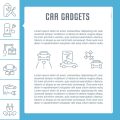Understanding Wheel Alignment
If you’ve ever cruised down Route 66 or taken a Sunday drive in your favorite ride, you know that every car has its own personality. But when your steering wheel starts to feel off-center or your tires seem to have a mind of their own, it might be time to think about wheel alignment. At its core, wheel alignment is the fine-tuning of your car’s suspension—making sure your wheels are angled perfectly according to manufacturer specs. This isn’t just a mechanical detail; it’s a classic piece of American motoring tradition, where the open road calls for smooth handling and dependable performance. Proper alignment keeps your vehicle tracking straight and true, just like the classic cars of yesteryear rolling confidently down Main Street. More than just comfort, alignment impacts tire wear, fuel efficiency, and most importantly, safety. Whether you’re piloting an old-school muscle car or a modern SUV, understanding alignment is key to preserving both your driving pleasure and your car’s legacy on the road.
Common Symptoms of Misaligned Wheels
When you’re cruising down the highway or weaving through city streets, your car should feel stable and predictable. But when the wheels are out of alignment, your ride can start dropping subtle—and not-so-subtle—hints that something’s off. Recognizing these classic signs during your daily commute or a spontaneous weekend road trip is key to preventing bigger headaches down the road. Let’s break down the most common symptoms of misaligned wheels:
Pulled in the Wrong Direction
If your steering wheel feels like it’s got a mind of its own, tugging your car left or right even on a straight stretch, it’s a telltale sign your alignment needs attention. This “pulling” effect can be subtle at first but gets worse over time, making driving more tiring and less safe.
Uneven or Rapid Tire Wear
Take a closer look at your tires next time you fuel up. Are the treads wearing down more on one edge than the other? Uneven tire wear is a classic indicator that your wheels aren’t hitting the pavement at the right angle. This not only shortens the life of your tires but can also impact traction and braking.
Quick Reference: Common Alignment Symptoms
| Symptom | What You’ll Notice |
|---|---|
| Pulling to One Side | Car drifts left or right when driving straight |
| Steering Wheel Off-Center | Logo isn’t centered when wheels are straight |
| Vibration in Steering Wheel | Noticeable shake, especially at higher speeds |
| Uneven Tire Wear | Tread worn more on one edge or spotty patches |
How to Spot Alignment Issues On-the-Go
You don’t need fancy equipment to catch these warning signs early. Pay attention to how your vehicle handles on straight roads, check your tire tread regularly, and listen for any unusual vibrations or noises coming from underfoot. If you notice any combination of these symptoms, it’s time to give your car some old-fashioned TLC with a professional wheel alignment before those minor issues become major repairs.
![]()
3. Why Alignment Matters: Safety, Savings, and Smooth Handling
Proper wheel alignment isn’t just a technical detail—it’s the secret behind those smooth, classic American road trips and everyday commutes. When your wheels are aligned, every part of your car works in harmony, just like the precision of a vintage Mustang cruising down Route 66. Let’s break down why alignment deserves your attention.
Extend Your Tire Life
Poor alignment causes uneven tire wear, meaning you’ll be shopping for new tires sooner than you’d like. Regular alignment checks help your tires last longer by ensuring each one makes even contact with the road. Think of it as preserving the craftsmanship of your ride—because there’s nothing nostalgic about shelling out for new rubber every year.
Boost Your Fuel Efficiency
Misaligned wheels create extra drag, forcing your engine to work harder and burn more gas. With fuel prices climbing higher than a classic muscle car at a stoplight, every mile per gallon counts. Proper alignment keeps your vehicle rolling straight and true, saving you money at the pump and keeping your journey efficient.
Savor That Legendary Smooth Handling
If you love the feeling of gliding down the highway with confidence and control, alignment is key. A well-aligned car handles predictably, hugging corners and tracking straight without pulling or wandering. It’s the difference between wrestling with your steering wheel and enjoying a cruise as effortless as Sunday morning coffee at a retro diner.
Reliability You Can Trust
Much like the timeless quality of American classics, proper alignment means fewer surprises on the road—less strain on your suspension and steering components, fewer unexpected repairs, and peace of mind that your car will deliver when you need it most.
The Bottom Line
Wheel alignment isn’t just about avoiding trouble; it’s about honoring the enduring spirit of American motoring—safety, savings, and an unmatched driving experience that stands the test of time.
4. What Causes Wheel Misalignment?
Wheel misalignment isn’t just a random quirk—it’s the result of the daily battles your car faces on American roads. Whether you’re navigating the classic potholes of Main Street or accidentally grazing the curb at your favorite drive-in, everyday moments can gradually nudge your wheels out of line. Let’s break down the most common culprits behind wheel misalignment:
| Cause | How It Happens | Classic Example |
|---|---|---|
| Potholes | Hitting deep potholes jars your suspension, knocking wheels out of alignment. | A rough winter leaves Main Street full of craters—your morning commute takes a toll. |
| Curbs | Bumping or scraping curbs can shift alignment instantly, especially during parking maneuvers. | You swing by the local drive-in and clip the curb while ordering burgers and shakes. |
| Speed Bumps & Road Debris | Going too fast over speed bumps or rolling over road debris can tweak alignment angles. | The neighborhood has new speed bumps—hit them too hard, and your steering feels off. |
| Accidents & Collisions | Even minor fender-benders can affect wheel position and suspension parts. | A gentle tap in a parking lot leaves more than just a dent—it messes up your alignment. |
| Worn Suspension Parts | Over time, ball joints, bushings, and tie rods wear out, causing wheels to drift out of alignment naturally. | Your trusty pickup is vintage cool—but those original parts might be overdue for replacement. |
Pro Tip: Even if you don’t remember a specific incident, daily wear and tear adds up. Regular check-ups help catch misalignments before they lead to bigger problems down the road—just like keeping that classic ride running smooth for years to come.
5. Solutions: What to Do If Your Car Needs an Alignment
When to Visit a Trusted Local Shop
If you notice symptoms like uneven tire wear, your steering wheel pulling to one side, or vibrations at highway speeds, it’s time to stop reminiscing about those smooth Sunday drives and get your car checked out. While it might be tempting to put off service in the hustle of daily life, delaying a wheel alignment can lead to more costly repairs down the road. Don’t wait—seek out a reputable local shop with skilled technicians who understand the classic craft of keeping wheels true.
What Happens During a Professional Wheel Alignment?
A professional alignment is far more than just adjusting your tires. Your mechanic will use specialized equipment to precisely measure and set your vehicle’s camber, caster, and toe angles according to manufacturer specifications. This careful process ensures every ride feels as steady and reliable as an American-made pickup from yesteryear. The technician will also inspect your suspension components and may recommend replacing worn parts before aligning the wheels for optimal results.
Tips for Maintaining Proper Wheel Alignment
Once your wheels are back in line, keep them that way by checking your tire pressure monthly and avoiding potholes or rough roads whenever possible—a tall order on some classic Main Streets, we know! Rotate your tires every 5,000–7,500 miles and have your alignment checked annually or after any hard impact. With these time-tested habits, you’ll keep your car rolling smoothly and preserve that nostalgic feeling of open-road freedom for years to come.
6. DIY vs. Pro: Should You Try Aligning Your Wheels at Home?
If you’re a hands-on car enthusiast, the idea of aligning your own wheels might sound appealing—a classic blend of American can-do spirit and backyard ingenuity. But before you break out the wrenches and jack stands, it’s worth weighing the risks and rewards of tackling this old-school job on your own.
The Case for DIY Alignment
Doing your own alignment can be satisfying, especially if you love getting under the hood and mastering your ride’s finer details. With some basic tools, online tutorials, and a level driveway, it’s possible to make minor adjustments to toe and camber. You’ll save money on labor costs and get that nostalgic sense of accomplishment that comes from doing things the classic way—just like granddad in his garage.
The Potential Pitfalls
However, wheel alignment is a precise science. Modern cars are engineered with tight tolerances that require specialized equipment—think laser-guided alignment racks and digital angle gauges—that most home garages just don’t have. If your measurements are even slightly off, you could end up with uneven tire wear, pulling, or even safety hazards on the open road. In short: the stakes are higher than they seem.
When to Call in the Pros
A seasoned mechanic brings years of experience and access to advanced tools. They’ll catch subtle issues you might miss, ensuring your vehicle meets factory specs for optimal handling and safety. If your car has complex suspension systems or you’ve noticed severe symptoms—like steering wheel vibration or rapid tire wear—it’s wise to let the pros handle it. After all, there’s no shame in relying on true craftsmanship when it comes to something as vital as your wheels.
The Bottom Line
While a home alignment can scratch the itch for DIY satisfaction, it’s often best reserved for minor touch-ups or vintage rides with simpler setups. For daily drivers and modern vehicles, trusting a professional is usually the safest bet—and a nod to America’s enduring respect for skilled trade work done right.


